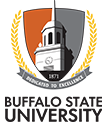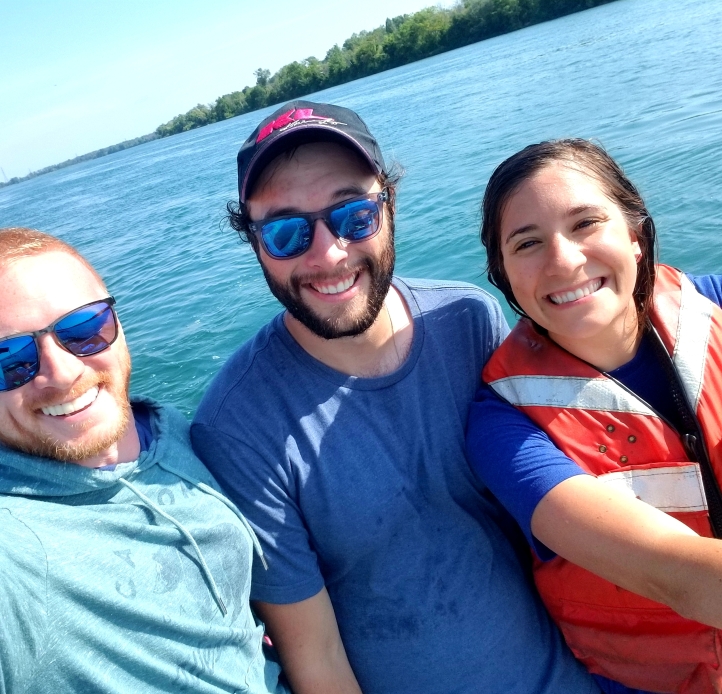
Great Lakes Center Newsletter: Issue 13
October 1, 2018
This issue focuses on summer research on the emerald shiner, monitoring the benthos of the Great Lakes, and a more intensive look at Lake Ontario. Also, WNY PRISM will be hosted by the GLC for another five years, the GLC joined the Great Lakes-Northern Forests CESU network, and GLES now stands for Great Lakes Environmental Science.
Emerald Shiner Crew 2.0
by Amy Cavanaugh, Ben Szczygiel, and Adam Sullivan, Biology M.A. graduate students

This summer saw the third and final field season of the Emerald Shiner Project. The emerald shiner population had not been examined for the two summers prior and this summer served as a final data point to wrap up the project. This season was staffed with an all new crew of Buffalo State students: Amy Cavanaugh, Benjamin Szczygiel, and Adam Sullivan.
This season was focused on assessing the population strength of the emerald shiners and evaluating their condition. These data serve as a comparison to the collections from 2014 and 2015, when there were a lot more shiners in the river. We fished most of the same sites as in previous years in the upper Niagara River; however, we fished them for longer periods of time to compensate for a decrease in fish catch. Our emerald shiner catches were the lowest this project has recorded. We analyzed the fish caught to determine their sex, gonad weight, and caloric content and compared the results to past sampling years. These results will enable us to determine the overall health of the shiners and possible physiological reasons that could contribute to their population decline in the river.
Participating in the Emerald Shiner Project was a great experience for the students in the crew for both field and laboratory techniques. The consistent weekly work allowed them to learn boating skills, dissection skills, and overall lab and field ability. The project also taught students the trials and tribulations involved in field work and the importance of adapting to field conditions to complete the work. The crew was also able to assist in several other projects and find specifically requested species, which gave them a glimpse into other ecological research being conducted at the Field Station.
Being out on the Niagara River all summer allowed the Emerald Shiner Crew to experience the biodiversity of this region. We became familiar with local fishes such as smallmouth bass, largemouth bass, carp, bowfins, redhorse, and many bird species. We were able to see firsthand the spread of invasive species, especially the round gobies along the shoreline. Knowing how essential the emerald shiner is to the food web of the Niagara River and the biodiversity of the region helped to give students a deeper appreciation for the importance of the project and ongoing research into emerald shiners.

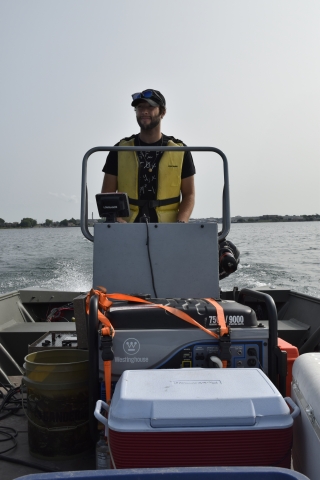

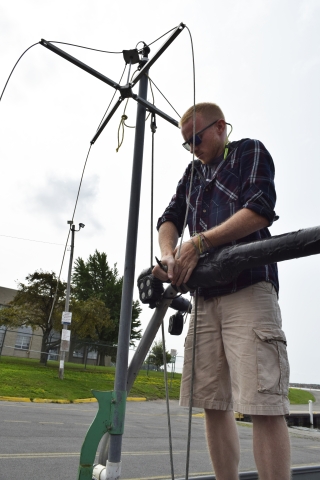
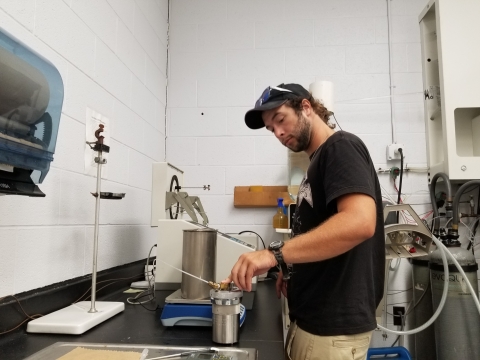

GLES programs receive facelift
by Kelly Frothingham, GLES program coordinator
The fall 2018 semester started with some changes for the GLES programs. Program revisions we started last year were approved in September by SUNY and the NYS Education Department. The revisions included a name change for both programs, so the M.A. and M.S. will now be called Great Lakes Environmental Science, rather than ecosystem science. This change better reflects the interdisciplinary environmental science focus of the programs and it is hoped that the new name will attract additional students to our master’s programs. Curriculum requirements changed slightly with the revisions.
We also welcomed seven new students to the programs: three started in the M.A. and four started in the M.S. The students come from a variety of undergraduate backgrounds ranging from biology to geography to environmental studies. They also came to Buffalo State from some of our undergraduate programs, as well as programs at the University at Buffalo, Cazenovia College, Paul Smith’s College, and Evergreen State College. We wish the students success as they work their way through their GLES M.A. or M.S.!
New species discovery
by Lyubov Burlakova and Alexander Karatayev

GLC researchers Lyubov Burlakova and Alexander Karatayev have just described Cyclonais necki, a new freshwater bivalve species from Texas, in collaboration with Arthur Bogan from North Carlonia State Museum of Natural Sciences and Manuel Lopes-Lima from the Interdisciplinary Center of Marine and Environmental Research (CIIMAR) at the University of Porto, Portugal. The species description was published in The Nautilus, one of the oldest peer-reviewed scientific journals in malacology, which published its first issue in 1886. This paper, “A new freshwater bivalve species of the genus Cyclonaias from Texas (Unionidae: Ambleminae: Quadrulini),” provides morphological and genetic description of the species.
Cyclonaias necki was found during the genetic revision of Cyclonaias based on specimens collected by Lyubov Burlakova, Alexander Karatayev, and Vadim Karatayev in Texas. Elsa Froufe and Manuel Lopes-Lima from CIIMAR led the genetic analysis, and Arthur Bogan, the prominent authority in unionid taxonomy, performed the morphological description of the species. We had the honor of naming the species after Dr. Raymond W. Neck (1946–2017), a well-known Texas zoologist, in recognition of his extensive and excellent work on Texas unionids.
Of the 14 Cyclonaias species recognized in North America, 6 were found in Texas. One of these species, the Texas Pimpleback Cyclonaias petrina (Gould 1855) is distributed across the Colorado and San Antonio/Guadalupe River systems. However, specimens collected in the San Marcos River of the same basin revealed clear conchological differences from C. petrina and were therefore described as a new species with a common name “Guadalupe Orb” based on shell morphology and molecular barcoding analyses. Considering the restricted range, we suggested that both the species, C. necki and C. petrina, warrant listing as endangered.
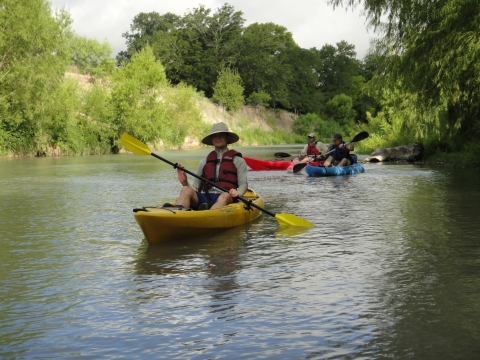
WNY PRISM refunded for 5 years
by Chris Pennuto

GLC research scientist and Professor of Biology Dr. Chris Pennuto was recently awarded a five-year, $3.5 million grant from the New York State Department of Environmental Conservation’s Environmental Protection Fund to continue operation of the Western New York Partnership for Regional Invasive Species Management office (WNY PRISM). There are eight PRISM offices throughout the state, and as the acronym implies, they work with local organizations having a stake in invasive species management.
This is the second consecutive time the GLC received this grant, allowing Pennuto and his team to continue their current invasive species management activities and enhance their scope of work throughout the WNY region. The WNY PRISM office provides expertise on invasive species management, coordination, and outreach education.
Currently, WNY PRISM is housed on the Buffalo State campus within the Great Lakes Center and has two full-time staff members: Andrea Locke (coordinator) and Lucy Nuessle (terrestrial invasive species manager). The grant will allow that number to increase to four, while also providing funds for 25 summer boat stewards and four summer management interns. The boat stewards program, which expands under the new grant from two boat stewards this past summer to 25, will provide a steward at 20 boat launches throughout the eight counties of Western New York from May through early September. They educate all the boaters that come and go from launch sites about invasive species in our lakes and rivers, and provide them with information on how to prevent the spread of invasive species while showing them techniques for cleaning, disinfecting, and drying their watercraft. Every recreational craft – be it kayaks, canoes, boats with motors and their trailers – is a potential vector for invasive species, their parts, or propagules.
The WNY PRISM program has engaged and supported the Western NY conservation and natural resource protection community extremely effectively to date. During its initial five-year agreement, the office conducted an average of 41 education and outreach events each year, reaching 3930 individuals directly and 221,924 total attendees annually. We engaged in individual invasive species management field activities at over 20 sites in five counties targeting 21 invasive species, coordinated projects with over 100 unique partners, and affected nearly 1950 hectares of land and water.
The office expanded its original programming throughout the first funding cycle, hosting NY DEC giant hogweed interns in summer 2016 and hosting two boat stewards in summer 2018, as well as securing several external grants to fund new initiatives like the Great Lakes Slender False Brome working group. The GLSFB working group also brought us a full-time project manager (Brittany Hernon) and four interns.
The region has entered roughly 8000 invasive species observations into iMapInvasives since the office was opened, and mapped 85 species throughout the 8 counties in 56 different locations. We provided 20 invasive species identification workshops and 15 management workshops. WNY PRISM looks forward to the next five years assisting the regional natural resource community in invasive species management and education.
CSMI Lake Ontario Survey 2018
by Knut Mehler
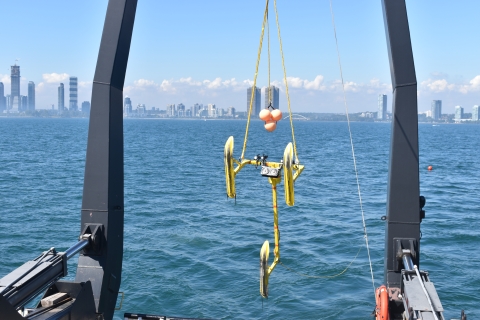
This September, Alexander Karatayev, Lyubov Burlakova, and Knut Mehler participated in the lake-wide benthic survey of Lake Ontario as part of the CSMI to assess the status of the macroinvertebrate community. Benthic samples were collected with a PONAR from 52 stations. Each PONAR grab was supplemented by a benthic video to better understand Dreissena spatial distribution along a depth-gradient. A preliminary analysis of the benthic videos reveled that Dreissena mussels can be found even at sites as deep as 250 m (820 ft)! At 25 near-shore stations a drop-down camera was deployed to monitor Dreissena on hard substrate. Results from the 2018 survey will be compared with those from previous years to analyze temporal trends in the benthic community.
Another interesting research project using underwater imagery was the application of a Sediment Profile Camera by Janet Nestlerode from U.S. EPA Gulf Ecological Division, Florida. Sediment profile images (SPI) offer an in situ view of the sediment-water interface and subsurface features in sediments, typically to approximately 25 cm below the sediment surface, yielding information on both quantitative and qualitative data on the biological, chemical, and physical character of the sediments. The SPI system was used in conjunction with sediment and benthic macrofaunal community sampling to explore sedimentary and biogenic features (measures), to explore possible relationships between these measures across a known stress gradient (e.g., organic enrichment, eutrophication), and use the results to test the concept that a suite of these measures can be developed into a reliable index of environmental stress or of benthic habitat quality for fresh water systems.
Another project was conducted by Ph.D. candidate Leon Katona from Wright State University, Ohio who is interested to quantify differences in algal communities inhabiting soft sediments and growing attached to dreissenid mussel shells across depth gradients in Lake Ontario. At each of the 52 sampling stations sediment cores and dreissenid mussels were collected for chlorophyll, organic matter analyses, and algal assemblage composition. Additionally, at a subset of sites, sediment cores were collected to estimate benthic primary productivity using a fluorometry to measure chlorophyll florescence.
Although our cruise was delayed for three days at the beginning it was a yet another successful CSMI survey which was accomplished due to the support, patience, and professionalism of the awesome crew of R/V Lake Guardian.

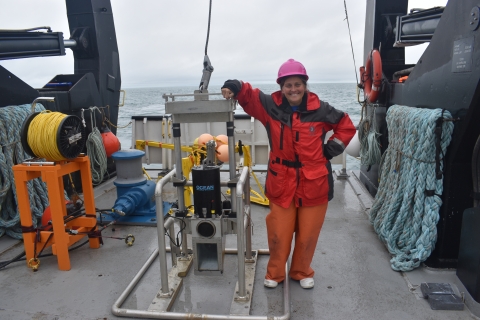

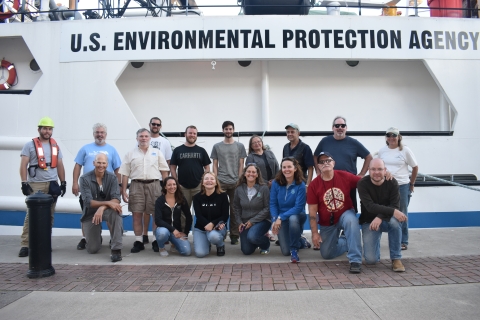
Summer Survey of the Great Lakes
by Susan Daniel

Great Lakes Center researchers completed yet another successful summer survey aboard the R/V Lake Guardian during the month of August. The 180-foot EPA vessel toted Susan Daniel and Knut Mehler through four Great Lakes (Michigan, Huron, Erie, and Ontario) for two weeks before stopping for a crew change in Rochester, NY. Then, Susan and Kit Hastings rejoined the 14 crew members and roughly 25 scientists in Sault Ste. Marie, Michigan several days later. Kit and Susan sampled Lake Superior for the next week.
Every year, the research vessel leaves Milwaukee, Wisconsin around August 1st, and samples Lakes Michigan, Huron, Erie, Ontario, and Superior during a month-long survey. All told, the ship traveled over 2,800 nautical miles (about 5,200 km) before completing the survey on August 28th.
Scientific crews from both Cornell University and SUNY Buffalo State rotated on a 12-hour shift while onboard. Their tasks while on duty included the collection of benthic macroinvertebrates, zooplankton, and chlorophyll in compliance with the U.S. EPA funded grant “Great Lakes Long-Term Biological Monitoring.” As per this obligation, 189 samples from 63 stations were collected using a PONAR grab sampler. These data will be added to the U.S. EPA benthic database that contains annual data from 1997. These samples, and previous data, will shed light on current environmental status of the Great Lakes and provide a baseline for any future changes in water quality.
In addition, researchers also collected sediment that may contain seeds from wetland plants in collaboration with Dr. Daniel Potts and Dr. Robert Warren. Their lab and students will expose the sediment to favorable growing conditions and identify seedlings to the lowest possible taxonomic level. Aquatic macrophyte seeds can withstand harsh conditions and are known to still be viable for decades, and thus historical macrophytes communities can be studied by growing seeds from lake sediment in a greenhouse. The sediment is being stored at SUNY Buffalo State in a refrigerator (1.5-4°C) and germination will be attempted in spring 2019. Stay tuned!
While on the survey, Kit and Susan experienced a bit of wildlife. First, during shore leave in Duluth, Minnesota, they stumbled upon a tricolored bumblebee (Bombus ternarius) enjoying some sweet nectar of a flower and doing the hard work of a pollinator. The second encounter happened in the middle of Lake Superior while sampling late one rainy night. Susan went outside and heard small birds chirping all around the ship; the chirps were coming from a flock of migrating magnolia warblers (Setophaga magnolia). Several exhausted travelers, on their way south from their breeding grounds in northern Minnesota and Canada, landed on the ship for a rest. One that we named Maggie landed in a dangerous spot, so crew members moved the small bird to safety until she was ready to continue her long journey. Maggie flew away, but the crew will always remember that beautiful, yellow bird. Overall, employees from GLC enjoyed a month of hard work, good food, and calm weather.

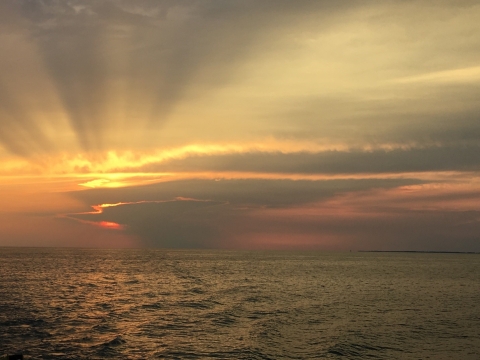

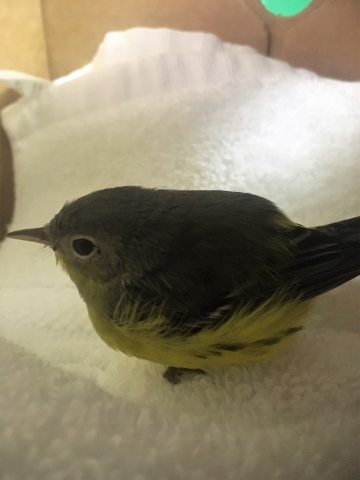
GLES graduate spotlight
by Kit Hastings
One of our recent GLES M.S. graduates, Jim Damon, was featured in the Buffalo News for his experience aboard the EPA’s research vessel Lake Guardian. Jim completed his internship with Buffalo Niagara Waterkeeper and is currently teaching science classes in the Buffalo Public Schools. In July, Jim was one of 15 educators from the Great Lakes region to board the Lake Guardian for the annual Shipboard Science workshop.
Jim says, “It was an awesome experience getting to participate in all the different sampling stations, learning the techniques to use the equipment, and helping to collect data for so many scientific studies. We analyzed some of the samples in the various labs on board the ship, allowing us to see instant results for our work. Many of the samples we collected will later be tested for mercury and PCBs, and for PAHCs and PFAS (often found in Teflon and water-resistant coatings), an emerging contaminant that only recently became included in EPA sampling. In addition to all the research and sampling, we got to meet research scientists and staff from various institutions, and the awesome and knowledgeable crew of the Lake Guardian.” Good luck teaching your students about the Great Lakes, Jim!
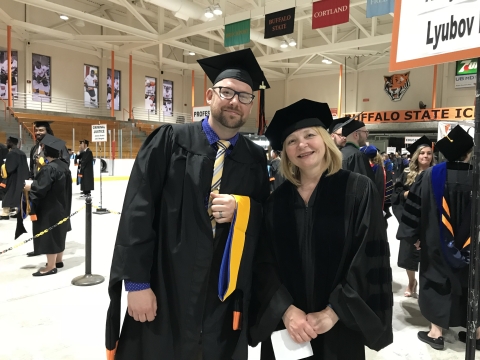
GLC joins CESU network
by Chris Pennuto
The Great Lakes Center is the newest partner in the Great Lakes-Northern Forests CESU network. CESU is the Cooperative Ecosystem Studies Unit, funded by USGS. There are multiple CESU networks across the country, each with a regional focus to address environmental research needs. According to the GLNF CESU: “The central mission of the Great Lakes-Northern Forest CESU is to conduct a program of research, technical assistance, and education that involves biological, physical, and social sciences needed to manage and preserve Great Lakes Northern Forest ecosystems. The region includes all or parts of 12 states and some the nation’s most significant water resources and forest lands. The GLNF CESU has 40 non-federal partners and 10 federal agency partners, making it one of the largest CESUs in the country.”
As a member of the CESU network, non-federal partners like the GLC are sought out to provide technical assistance or research support for issues critical to the USGS mission. For example, Dr. Chris Pennuto was recently awarded a 1-year, cooperative agreement to provide assistance in understanding the seasonal nutrient conditions in and around Cladophora beds in nearshore Lake Ontario. That work will require extensive diving collections of benthic algae and water samples from multiple depth zones throughout the growing season. Since Dr. Pennuto and GLC staff have extensive experience collecting and assessing Cladophora in Lake Ontario as part of past research efforts, they were able to provide CESU with technical expertise.
The GLC and supporting Departments of Biology and Geography & Planning offer the GLNF CESU technical expertise in multiple research areas including invasive species ecology, geospatial analysis, trophic interactions and food web structure, and riparian zone dynamics, as well as having the ability to support a wide range of activities requiring research vessels for working on the Great Lakes and its adjoining rivers. GLC staff are excited to extend their capabilities to the CESU network.
